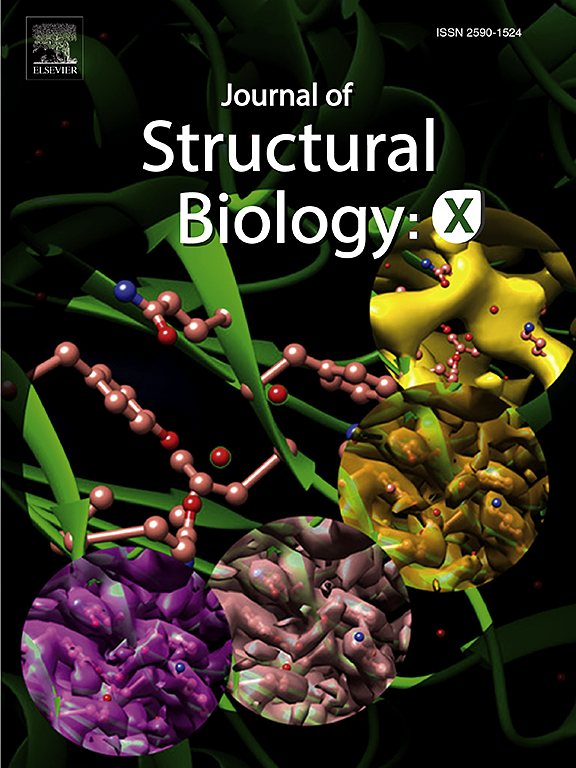3D distribution of biomineral and chitin matrix in the stomatopod dactyl club by high energy XRD-CT
IF 2.7
3区 生物学
Q3 BIOCHEMISTRY & MOLECULAR BIOLOGY
引用次数: 0
Abstract
Stomatopods are ferocious hunters that use weaponized appendages to strike down their pray. The clubs of species such as Odontodactylus scyllarus undergo tremendous forces, and in consequence they have intricate structures, consisting of hydroxyapatite, chitin, amorphous calcium phosphate and carbonate, and occasionally calcite. These materials are distributed differently across the four major zones of the dactyl club: the impact, periodic lateral and medial, and striated regions. While stomatopod clubs and their structure have been studied for a long time, studies have thus far been constrained to 2D mapping experiments with moderate resolution due to difficulties in preparing whole club thin sections, and absorption tomography that gives information on densities but not molecular length scales. To address this problem, and shed light on the structure of entire clubs, we herein used X-ray powder diffraction computed tomography (XRD-CT) using high energy X-rays at the P07 beamline of PETRA-III to allow penetrating the large samples whilst still obtaining high resolution information. This allowed mapping the 3D distribution of diffraction phases including the biomineral apatite and the semi-crystal chitin matrix. This showed that hydroxyapatite forms an envelope around the club, and that chitin forms 2D sheets in the periodic region of the club.
通过高能 XRD-CT 观察口足类双足俱乐部中生物矿物质和甲壳素基质的三维分布。
节肢动物是凶猛的猎手,它们使用武器化的附肢来击倒它们的猎物。齿龙(Odontodactylus scyllarus)等物种的棍棒承受着巨大的力量,因此具有复杂的结构,由羟基磷灰石、甲壳素、无定形磷酸钙和碳酸钙组成,偶尔还有方解石。这些物质以不同的方式分布在双齿龙骨的四个主要区域:冲击区、周期性外侧区、内侧区和横纹区。虽然对口足类俱乐部及其结构的研究由来已久,但由于难以制备整个俱乐部的薄切片,以及吸收层析技术只能提供密度信息而无法提供分子长度尺度信息,因此迄今为止的研究仅限于分辨率适中的二维绘图实验。为了解决这个问题,并揭示整个球杆的结构,我们在 PETRA-III 的 P07 光束线使用高能 X 射线粉末衍射计算机断层扫描(XRD-CT),以便在获得高分辨率信息的同时穿透大型样品。这样就可以绘制衍射相的三维分布图,包括生物矿物磷灰石和半晶体甲壳素基质。结果表明,羟基磷灰石在球杆周围形成一个包层,甲壳素在球杆的周期性区域形成二维薄片。
本文章由计算机程序翻译,如有差异,请以英文原文为准。
求助全文
约1分钟内获得全文
求助全文
来源期刊

Journal of structural biology
生物-生化与分子生物学
CiteScore
6.30
自引率
3.30%
发文量
88
审稿时长
65 days
期刊介绍:
Journal of Structural Biology (JSB) has an open access mirror journal, the Journal of Structural Biology: X (JSBX), sharing the same aims and scope, editorial team, submission system and rigorous peer review. Since both journals share the same editorial system, you may submit your manuscript via either journal homepage. You will be prompted during submission (and revision) to choose in which to publish your article. The editors and reviewers are not aware of the choice you made until the article has been published online. JSB and JSBX publish papers dealing with the structural analysis of living material at every level of organization by all methods that lead to an understanding of biological function in terms of molecular and supermolecular structure.
Techniques covered include:
• Light microscopy including confocal microscopy
• All types of electron microscopy
• X-ray diffraction
• Nuclear magnetic resonance
• Scanning force microscopy, scanning probe microscopy, and tunneling microscopy
• Digital image processing
• Computational insights into structure
 求助内容:
求助内容: 应助结果提醒方式:
应助结果提醒方式:


